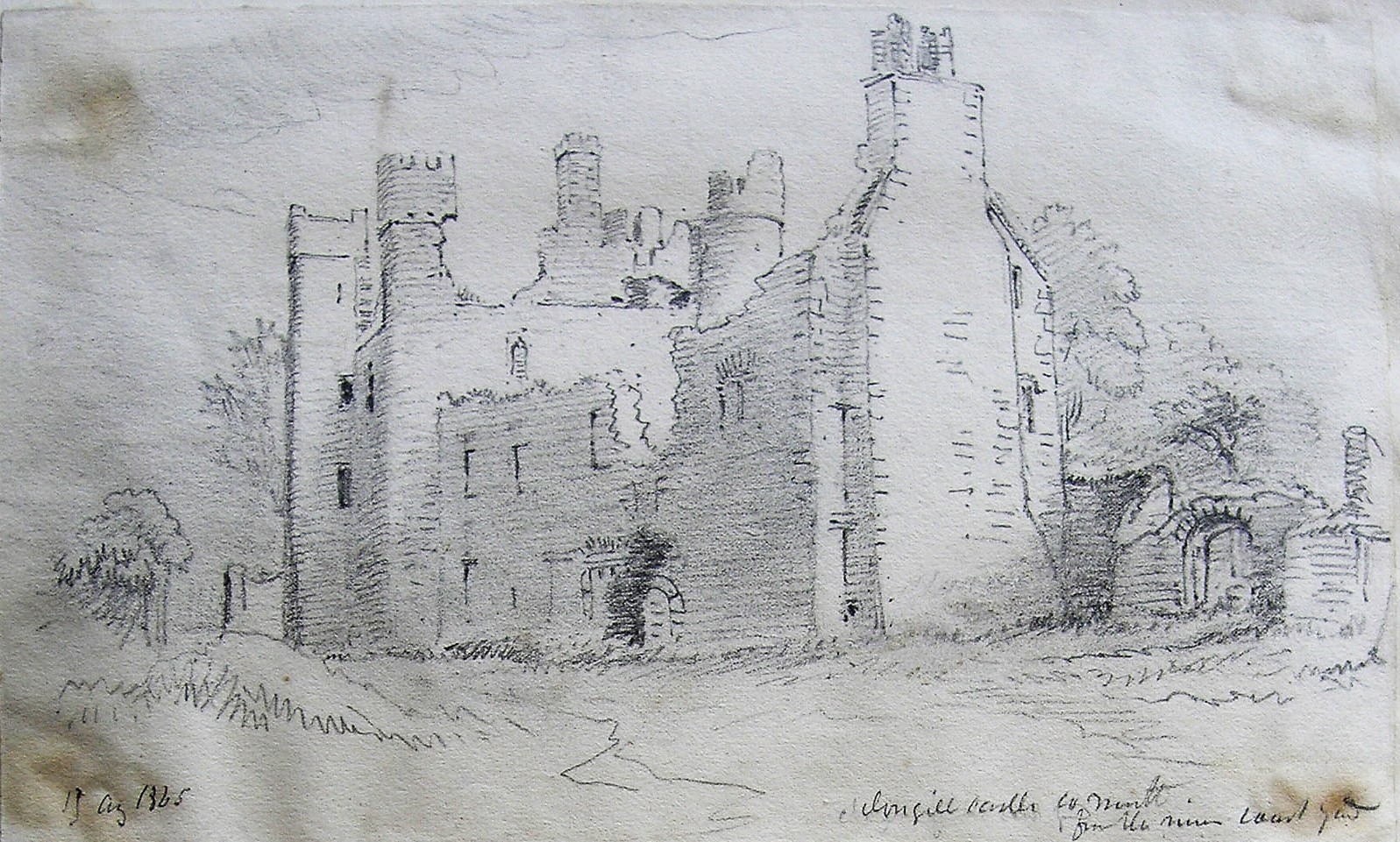Clongill

Clongill Castle from the main court yard. Drawn 11 Aug 1865 by George Victor DuNoyer
Picture Source: https://www.europeana.eu/portal/en/record/2058619/object_DP_7921155.html
Clongill Castle is located between Oristown and Wilkinstown. It is a combination of two houses, a medieval tower house with two round turrets and a two storey gabled house added in the sixteenth or seventeenth century. The bottom floor of the tower house was barrel vaulted and there are traces of wickerwork which was used to create the roof. There was a murder hole over the entrance. On the first floor there was a garderobe. The later stone house is a rectangular two storey building attached to the west end of the tower house. Connected to the earlier building through the original door of the tower house, the building has a circular tower with stairs and the remains of an oven and fireplace.
The building is associated with the White family. One of the earliest records of Whites at Clogill is Richard White of Clongill who was in England in 1352. A number of members of the White family were recorded as rectors of the parish. In 1598 Patrick White of Clongell was recorded as one of the noblemen of Eastmeath. Jane Netterville married Christopher White of Clongill in early seventeenth century. In the 1650's James White lived at Clongill and there was a castle and mansion house in the townlan It is said that the castle attacked by forces of Cromwell. It took the Cromwellian forces three weeks to capture the castle. The tradition is that the White family were wiped out at the time with the exception of Patrick White and his brother Robert White that were in the French army at the time of the massacre. A pedigree of the White family of Clongell and Ballymore, Co. Westmeath dating from 1550 to 1735 is in the National Library of Ireland.
General Scurlog Williams lived at Clongill Castle in the early eighteenth century. His daughter was maid of honour to Queen Mary. The castle and lands were acquired by Thomas Gerrard in the mid seventeen to early eighteenth century. Samuel Gerrard lived at Clongill until the middle of the eighteenth century. Swift wrote as number of letters to Samuel Gerrard of Clongill Castle in the early 18th century. Gerrard was assisting Swift in the purchase of lands for his hospital in Dublin. Samuel Gerrard resided in the house until his death in 1750. In 1813 Mr. Pollock and Mr. Gerrard joined their packs together to form the Clongill pack which was based at Clongill Castle. In 1837 Clongill was described as an ancient castle in a tolerably good state of preservation. Nearby Arch Hall was held by the Garnett family.
Source: meath-roots.com
*******
Riocht na Midhe, 2016 page 120;
Poverty in the midst of affluence in the nineteenth century County Meath civil parishes of Clongill and Kilberry by James Caffrey.
“The study will concentrate on sources relating to the origin, size and type of farm holding, the nature and extent of agricultural production and the density and social standing of the population supported by the holdings in order to establish the reasons for the extreme nineteenth century economic divergence in these adjoining townlands.”
“The Garnetts and Gerrards, oblivious to neighbouring poverty, availed of opportunities to display their status and wealth at that time. Garnett completely transformed his early Georgian house, adding a third storey, and Lieutenant Colonel Thomas Gerrard commissioned a new chariot in 1829, a full description of which runs to two pages.”
*******
Slater's Directory, 1894
Clongill, a parish in Co. Meath, barony of Morgallion, union of Navan, diocese of Meath, 5 miles north west from Navan and 2 south west from Wilkinstown station on the Midland Great Western railway, containing six townlands. There is a Catholic chapel and a parochial school. The area comprises 2,386 acres; the population in 1891 was 155.
Private Residents:
Garnett, John Paine j.p. Arch hall.
Stopford, James U. Oristown.